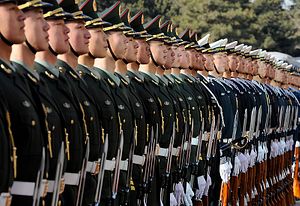If you have been following China’s military in recent months, you know big changes are afoot. The People’s Liberation Army (PLA) is cutting its force, establishing a joint staff – and confusingly an Army staff as well – and reorganizing regional commands. Most tellingly this is all happening at President Xi Jinping’s behest. What’s changed and why?
PLA experts Ken Allen, Dennis Blasko, and John Corbett have provided the best overview so far, listing the goals of reorganization as establishing a “joint operational command authority,” rebalancing the services, and reducing non-combat units. The theme is reduction, mainly from the Army, as reflected in Xi’s call to shed 300,000 troops.
Functional Departments
On January 11, the Central Military Commission (CMC) reconfigured its four general departments into 15 functional departments, commissions, and offices under the direct control of the CMC. The former general departments saw certain subordinate offices and functions cut away to form separate, coequal departments. Dr. Ying Yu Lin provides thorough analysis of the specifics.
Of greatest interest is the General Staff Department, which had most of its portfolio spun off into separate offices or transferred to other organizations. Militia mobilization, military training, strategic planning, organizational structure, and international military cooperation all became independent departments. Intelligence and technical reconnaissance went to form the core of the newly established PLA Strategic Support Force (PLASSF). Ground force-specific functions shifted to the new Army staff organization.
Despite this significant reduction in scope, PLA analyst James Mulvenon explains that the “most important of the new CMC organizations is the Joint Staff Department, which is likely the command interface between the CMC leadership and the new theater… commands.” Although the Joint Staff is now just one department among 15, it is the only office with both the capability and clout to give fighting direction to PLA forces.
Service Staffs
Three new PLA service staffs, called “leading organizations,” were unveiled in December 2015: the Army (PLAA), Rocket Force (PLARF, formerly Second Artillery), and PLASSF. Unlike some nations’ service headquarters, the PLA’s traditional service staffs (Navy, Air Force, and now Army) will not command their services directly. Instead they will oversee “military construction,” the organization, manning, and equipping of the service’s units, similar to U.S. service headquarters.
Theater Commands
On February 1, the CMC established five new joint theater commands: Eastern, Southern, Western, Northern, and Central Theater Commands. Each command will have Army, Navy, and Air Force components based on each service’s former regional headquarters, similar to U.S. Combatant Commands. This completes a three-tiered combat command system with authority emanating from the CMC through the theater commands down to combat units. Despite the joint mandate, the highest leaders of each command hail from the Army, suggesting that the CMC has left significant room for development into a truly joint force.
It appears that PLARF and PLASSF agencies and units have not been placed under the theater commands, suggesting that their parent services may play a greater role in their management. Further reforms will include capabilities modernization, professional military education reform, and reductions in the citizen militia.
Bottom Line
Mulvenon points to Xi Jinping’s coup in carrying out the PLA’s most sweeping reorganization since Deng Xiaoping as another indicator of his political stature, particularly in relation to the last two presidents. I believe this is a more rational structure better suited to a modern joint force. However, it will take longer than the projected 2020 timeline for the new structure to become a functioning joint organization.

































